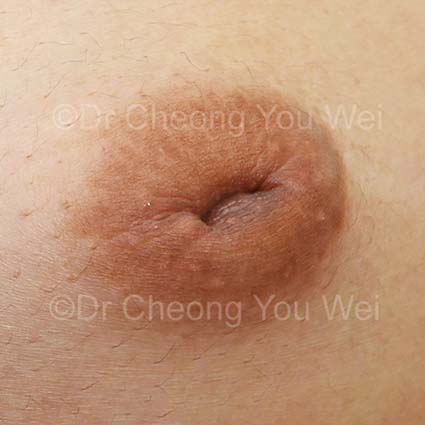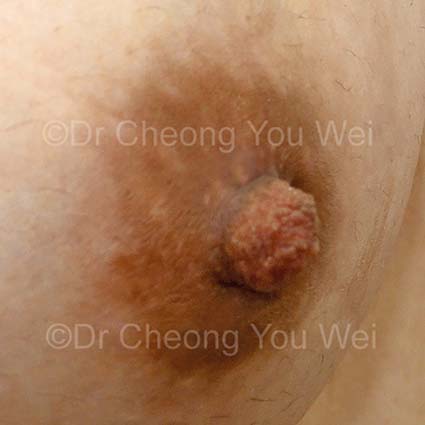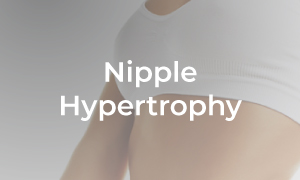Correction of Inverted Nipple
- Inverted Nipple Case 1: Before
- Inverted Nipple Case 1: After
- Inverted Nipple Case 2: Before
- Inverted Nipple Case 2: After
A normal nipple should point outward. An inverted nipple is a condition where the nipple is pointing inward or retracted into the breast. The inverted nipples are pulled inwards by shorted lactiferous ducts (milk ducts) and fibrotic tissue. This condition can happen in one breast or both. Inverted nipples are not uncommon and are mostly congenital. Another cause is fibrosis caused by inflammation such as a breast abscess or chronic mastitis. Inverted nipples can also be caused by trauma, breastfeeding and aging. However, if a previously normal nipple begins to turn inward without reason, it may well signal a breast tumour beneath. This should be immediately reported to doctor.
Inverted nipples can be graded based on the severity:
- Grade 1. The nipple can easily be pulled outward, and will sometimes stand out on its own with or without any stimulation. Breastfeeding is usually not affected.
- Grade 2. The nipple can be pulled outward, but it quickly retracts back into the breast once the pull is released. Breastfeeding may or may not be a problem.
- Grade 3. The most severe condition. The inverted nipple cannot be pulled out physically at all. Breastfeeding often is affected. Treatment of Grade 3 inverted nipples is by surgical correction.
The concern of inverted nipples is largely aesthetic. The patient may feel embarrassed due to the abnormal appearance of the nipples. Inverted nipples may interfere with breastfeeding because of the abnormal milk ducts underneath, and it could also be difficult for baby to latch on an inverted nipple. There may be an issue with nipple hygiene as dirt and debris may get trapped in the inverted nipple.
Preparation
-
-
-
Inform the doctor of any pre-existing medical conditions and drug allergy. All medical conditions must be treated and stabilized before surgery.
-
Stop smoking at least one week before surgery. Smoking is harmful to wound healing and increases the risks of other post-operation complications.
-
Stop the following medications and supplements from one week before surgery until one week after surgery.
-
All supplements containing vitamin E, ginseng, ginkgo, garlic, fish oil, and other ingredients that increase bleeding during the procedure. Other supplements, traditional medicine, and herbs, in which ingredients are unknown, have to stop as well.
-
Medicine that increases bleeding during the procedure such as aspirin, NSAIDs, and warfarin. However, you may need to consult your physician who prescribed the medication before you stop them.
-
-
-
On the day of surgery, wear simple and comfortable clothing. Do not wear any makeup. Do not wear any jewelry and metal objects on the face and body.
Surgery
Duration: one hour
Anaesthesia: Local anaesthesia
Hospitalization: Not required
Recovery*: Back to work the next day, light exercise after one week, heavy exercise after 3-4 weeks. *The actual speed of recovery may vary from person to person.
Technique: Small incisions are made around the base of the nipple to release the tethering tissues that pull the nipple inwards. Lactiferous ducts may or may not be sectioned for the release, depending on the severity of the condition. The nipple is pulled out and maintained in that position by placing a series of sutures . In severe cases, the surgeon may use a tissue graft to reinforce the base of the nipple to prevent retraction from recurring.
Post-operative Care**
-
-
-
What to expect:Swelling usually peaks on the second to third day after surgery and will gradually subside after that. Post-operative pain is usually minimal.
-
General care:
-
Avoid pressure on the nipple. Wear loose bra.
-
Avoid smoking for at least one month. Smoking increases the risk of wound complications.
-
Adequate rest and adequate sleep are helpful for a speedy recovery.
-
Be relaxed and calm. Contact the clinic if there are any queries.
-
-
Medicine:Finish the oral antibiotics as prescribed. Take the painkiller when necessary.
-
Wound care: Leave the wound dressing on until coming back for review. Change the dressing if it gets dirty or soaked. Clean the wound with a clean cotton tip soaked with sterile water/saline. After that, apply antibiotic ointment.
-
Physical activity:Avoid heavy physical activity and exercise for at least one month.
-
Follow-up:Come back one week after surgery for review and removal of sutures.
-
Emergency:If there is heavy bleeding, a rapid increase in swelling or severe pain, contact the clinic/doctor for advice immediately.
-
-
**The instructions in this list are only for general guidance. If you have any specific queries or concerns during the post-operative recovery, please contact the clinic for further advice.












